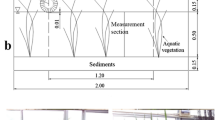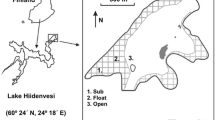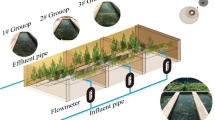Abstract
Aquatic macrophytes play a central role in preserving the ecological equilibrium of shallow lakes and in the restoration of eutrophic lakes that have switched to phytoplankton-dominated turbid water. Massaciuccoli Lake, a shallow lake located along the Tuscan coast in Italy, has shown a constant and progressive simplification of the submerged plant community, for anthropogenic reasons, leading, in recent years, to turbid water. The growth and nutrient absorption capability of two macrophyte species, Myriophyllum verticillatum L. and Elodea canadensis Michaux, in the lake was investigated, with the prospect of a future lake restoration programme centred on their replacement. Mesocosm experiments were conducted to monitor the plant growth and nutrient (NO −2 , NO −3 , NH +4 , Ntot, PO 3−4 , Ptot) content in the plant dry matter and water at the beginning and at the end of the trial. Bacterial activity was analysed in the water in order to verify the possible nutrient absorption contribution by organisms other than plants. Both M. verticillatum and E. canadensis showed satisfactory growth and nutrient reduction in the water body. Moreover, their different growth patterns suggested that optimal replacement can be performed with their introduction in two steps, starting with M. verticillatum, which shows the best capacity to colonise the aquatic environment, due to its tendency towards lengthening.





Similar content being viewed by others
References
Abernethy VJ, Sabbatini MR, Murphy KJ (1996) Response of Elodea canadensis Michx. and Myriophyllum spicatum L. to shade, cutting and competition in experimental culture. Hydrobiologia 340:219–224
Barbaresi S, Gherardi F (2000) The invasion of the alien crayfish Procambarus clarkii in Europe, with particular reference to Italy. Biol Inv 2:259–264
Barko JW, James WF (1998) Effects of submerged aquatic macrophytes on nutrient dynamics, sedimentation, and resuspension. In: Jeppesen E, Søndergaard Ma, Søndergaard Mo, Christoffersen K (eds) The structuring role of submerged macrophytes in lakes. Ecological Studies, vol 131. Springer-Verlag, New York, pp 197–214
Barrat-Segretain MH, Amoros C (1996) Recolonization of cleared riverine macrophyte patches: importance of the border effect. J Veg Sci 7:769–776
Best MD, Mantai KE (1978) Growth of Myriophyllum: sediment or lake water as the source of nitrogen and phosphorus. Ecology 59:1075–1080
Blindow I, Andersson G, Hargeby A, Johansson S (1993) Long-term pattern of alternative stable states in two shallow eutrophic lakes. Freshw Biol 30(1):159–167
Brix H (1997) Do macrophytes play a role in constructed treatment wetlands? Water Sci Technol 35:11–17
Brix H, Schierup HH (1989) Use of aquatic macrophytes in water-pollution control. Ambio 18(2):100–107
Butcher RW (1933) Studies on the ecology of rivers: I. On the distribution of macrophytic vegetation in the rivers of Britain. J Ecol 21:58–91
Carignan R, Kalff J (1980) Phosphorus sources for aquatic weeds: water or sediments? Science 207:987–989
Cataldo DA, Haroon M, Schrader LE, Youngs VL (1975) Rapid colorimetric determination of nitrate in plant tissue by nitrification of salicylic acid. Commun Soil Sci Plant Anal 6:71–80
Ceccarelli N, Piaggesi A, Ciurli A, Alpi A (1997) Residui di diserbanti nelle acque del lago di Massaciuccoli: effetti tossici sulle macrofite acquatiche e analisi delle concentrazioni. In: Lago di Massaciuccoli: 13 ricerche finalizzate al risanamento. Universitaria Litografica Felici, Pisa, Italy, pp 181–202
Coops H, Doef RW (1996) Submerged vegetation development in two shallow, eutrophic lakes. Hydrobiologia 340:115–120
Cuppen JGM, Van den Brink PJ, Vann der Woude H, Zwaardemaker N, Brock TCM (1997) Sensitivity of macrophyte-dominated freshwater microcosms to chronic levels of the herbicide linuron. II. Community metabolism and invertebrates. Ecotoxicol Environ Saf 38:25–35
Eugelink AH (1998) Phosphorus uptake and active growth of Elodea canadensis Michx. and Elodea nuttallii (Planch.) St. John. Water Sci Technol 37:59–65
Howard-Williams C, Allanson BR (1981) Phosphorus cycling in a dense Potamogeton pectinatus L. bed. Oecologia 49:56–66
Jasser I (1995) The influence of macrophytes on a phytoplankton community in experimental conditions. Hydrobiologia 306:21–32
Jeppesen E (1998) The ecology of shallow lakes—trophic interactions in the pelagial. BSc dissertation. NERI Technical Report no. 247, 420 pp
Johnson CM, Ulrich A (1959) Analytical methods for use in plant analysis. Bulletin 766, University of California, Agricultural Experiment Station, Berkeley, CA, pp 26–78
Kemp WM, Boynton WR, Twilley RR, Stevenson JC, Ward LG (1984) Influences of submersed vascular plants on ecological processes in upper Chesapeake Bay. In: Kennedy V (ed) The estuary as a filter. Academic Press, Orlando, FL
Kemp WM, Boynton WR, Lubbers L (1990) Variations in structure of estuarine fish communities in relation to abundance of submersed vascular plants. Mar Ecol Prog Ser 65:1–14
Körner S, Nicklisch A (2002) Allelopathic growth inhibition of selected phytoplankton species by submerged macrophytes. J Phycol 38:862–871
Lauridsen TL, Pedersen LJ, Jeppesen E, Søndergaard M (1996) The importance of macrophyte bed size for cladoceran composition and horizontal migration in a shallow lake. J Plankton Res 18:2283–2294
Little ECS (1979) Handbook of utilization of aquatic plants. A review of world literature. FAO Fisheries Technical Paper no. 187 (FIRI/T187), UN, Rome
Lorenzen CJ, Jeffrey SW (1980) Determination of chlorophyll and phaeopigments: spectrophotometric equations. Limnol Oceanogr 12:343–346
Lürling M, van Geest G, Scheffer M (2006) Importance of nutrient competition and allelopathic effects in suppression of the green alga Scenedesmus obliquus by the macrophytes Chara, Elodea and Myriophyllum. Hydrobiologia 556:209–220
Mason CF (1997) Massaciuccoli Lake—trophic status and a review of possible solutions. In: Lago di Massaciuccoli: 13 ricerche finalizzate al risanamento. Universitaria Litografica Felici, Pisa, Italy, pp 379–388
McCrady MH (1915) The numerical interpretation of fermentation-tube results. J Infect Dis 17:183–212
Ministerial Decree (Decreto Ministeriale) 391/2003. Gazzetta Ufficiale—Serie Generale n.39 del 17-2-2004, pp 4–6 (in Italian)
Moss B (1990) Engineering and biological approaches to the restoration from eutrophication of shallow lakes in which aquatic plant communities are important components. Hydrobiologia 200/201:367–377
Nayar S, Chou LM (2003) Relative efficiencies of different filters in retaining phytoplankton for pigment and productivity studies. Estuar Coast Shelf Sci 58:241–248
Peeler JT, Houghtby GA, Rainosek AP (1992) The most probable number technique. In: Compendium of methods for the microbiological examination of foods, 3rd edn, pp 105–120
Pensabene G, Frascari F, Cini C (1997) Valutazione quantitativa del carico di nutrienti e dei solidi sospesi immessi nel Lago di Massaciuccoli dai comprensori della bonifica di Vecchiano e di Massaciuccoli. In: Lago di Massaciuccoli: 13 ricerche finalizzate al risanamento. Universitaria Litografica Felici, Pisa, Italy, pp 131–148
Petr T (2000) Aquatic macrophytes versus phytoplankton. In: Interactions between fish and aquatic macrophytes in inland waters. A review. FAO Fisheries Technical Paper no. 396, UN, Rome, 185 pp
Petrini C, Bazzocchi R, Moretti C (1996) La fitodepurazione. Agricultura 2:12–14
Pitt JA, Kelly A, Phillips GL (1997) Control of nutrient release from sediments. In: Madwick FJ, Phillips GL (eds) Restoration of the Norfolk Broads—final report. Broads Authority and Environment Agency, Norwich, UK
Reynolds CS (1991) Lake communities: an approach to their management for conservation. In: Spellerberg JF, Goldsmith FB, Morris MG (eds) The scientific management of temperate communities for conservation. Blackwell Scientific Publications, Oxford
Rose C, Crumpton WG (1996) Effects of emergent macrophytes on dissolved oxygen dynamics in a prairie pothole wetland. Wetlands 16:495–502
Rozas LP, Odum WE (1988) Occupation of submerged aquatic vegetation by fishes: testing the roles of food and refuge. Oecologia 77:101–106
SAS Institute (1990) SAS user’s guide: basics. SAS Institute, Cary, NC
Schmidt EL, Belser LW (1982) Nitrifying bacteria. In: Page A (ed) Methods of soil analysis, part 2. Chemical and microbiological properties. American Society of Agronomy, Inc., Crop Science Society of America, Inc., and Soil Science Society of America, Inc. Madison, Wisconsin, pp 1027–1042
Schriver P, Bøgestrand J, Jeppesen E, Søndergaard M (1995) Impact of submerged macrophytes on fish-zooplankton-phytoplankton interactions: large-scale enclosure experiments in a shallow eutrophic lake. Freshwater Biol 33:255–270
Schutten J, Dainty J, Davy AJ (2005) Root anchorage and its significance for submerged plants in shallow lakes. J Ecol 93:556–571
Smith CS (1978) Phosphorus uptake by roots and shoots of Myriophyllum spicatum L. PhD thesis, University of Wisconsin, Madison
Søndergaard M, Jensen JP, Jeppesen E, Møller PH (2002) Seasonal dynamics in the concentrations and retention of phosphorus in shallow Danish lakes after reduced loading. Aquat Ecosyst Health Manage 5:19–29
Strand JA, Weisner SEB (2001) Dynamics of submerged macrophyte populations in response to biomanipulation. Freshw Biol 46:1397–1408
Stuart NW (1936) Adaptation of the micro-Kjeldahl method for the determination of nitrogen in plant tissues. Plant Physiol 11(1):173–179
Thiébaut G (2005) Does competition for phosphate supply explain the invasion pattern of Elodea species? Water Res 39:3385–3393
Vaithiyanathan P, Richardson CJ (1997) Nutrient profiles in the everglades: examination along the eutrophication gradient. Sci Total Environ 205:81–95
Van Donk E, Van de Bund WJ (2002) Impact of submerged macrophytes including charophytes on phyto- and zooplankton communities: allelopathy versus other mechanisms. Aquat Bot 72:261–274
Wetzel RG (1964) A comparative study of the primary productivity of higher aquatic plants, periphyton, and phytoplankton in a large, shallow lake. Int Rev Ges Hydrobiol 49:1–61
Acknowledgement
This work was funded by Parco Naturale di Migliarino San Rossore Massaciuccoli, Pisa, Italy.
Author information
Authors and Affiliations
Corresponding author
Rights and permissions
About this article
Cite this article
Ciurli, A., Zuccarini, P. & Alpi, A. Growth and nutrient absorption of two submerged aquatic macrophytes in mesocosms, for reinsertion in a eutrophicated shallow lake. Wetlands Ecol Manage 17, 107–115 (2009). https://doi.org/10.1007/s11273-008-9091-9
Received:
Accepted:
Published:
Issue Date:
DOI: https://doi.org/10.1007/s11273-008-9091-9




